Studio Visit
In Her Home Studio, Artist Maya Varadaraj Paints Massive Portraits to a Soundtrack of ‘Harry Potter’ Movies, Her Cat by Her Side
The artist's solo exhibition "No Feeling Is Final" is currently on view at New York's Aicon Contemporary.
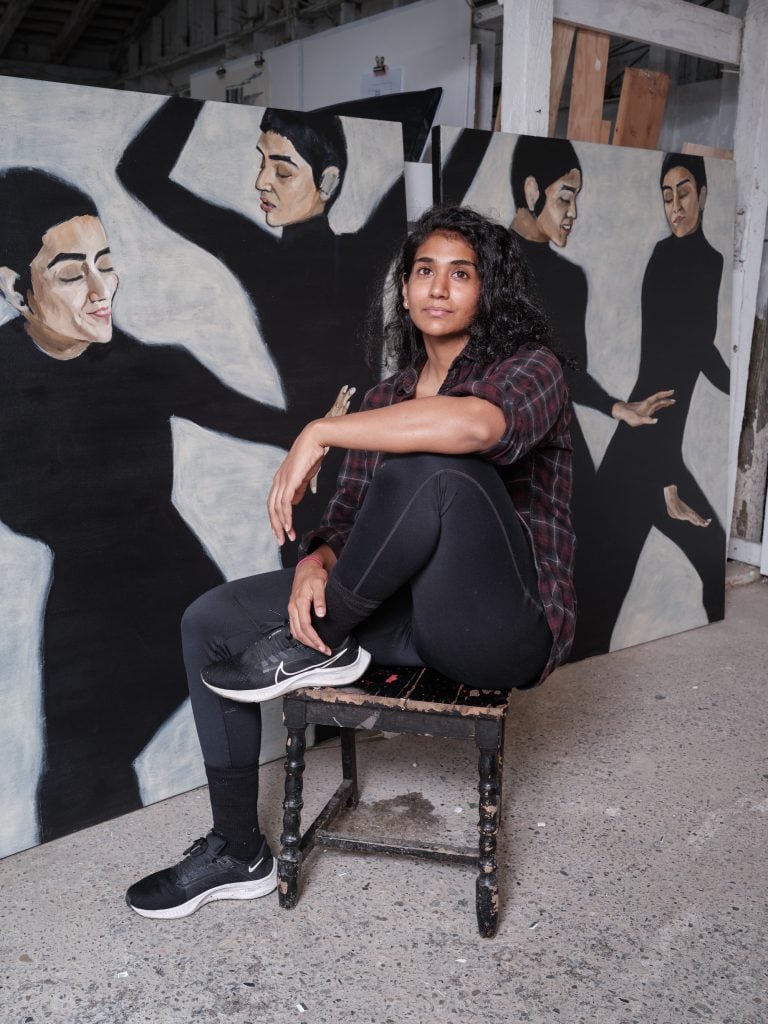
The artist's solo exhibition "No Feeling Is Final" is currently on view at New York's Aicon Contemporary.

Katie White

Artist Maya Varadaraj (b. 1989) believes in the alchemical possibilities of ancestral connection; the up-and-coming artist taps into her familial stories when creating her deeply felt paintings and ceramics.
Varadaraj, who grew up in India and now lives and works in New Rochelle, New York, has mined family photographs for inspiration since 2020, painting her relatives’ likenesses on raw linen canvas, a material that hints at India’s colonial history and her family’s work in textiles. The artist first found herself drawn to photographs of her relatives as a way of processing her own experiences with pregnancy loss and better connecting to the generations of women in her family before her. She describes this process as “incredibly therapeutic.”
But the ways Varadaraj engages with these personal materials are constantly adapting. In preparing for her current solo exhibition, “No Feeling Is Final,” at New York’s Aicon Contemporary, the artist found inspiration while reading Rainer Maria Rilke’s Letters to a Young Poet (the exhibition title takes its name from a line in the letters.
Varadaraj decided to write personal letters to each of her subjects before she began her latest series of portraits; though the letters were never sent, the process of writing offered an emotional extrapolation of each image and its significance.
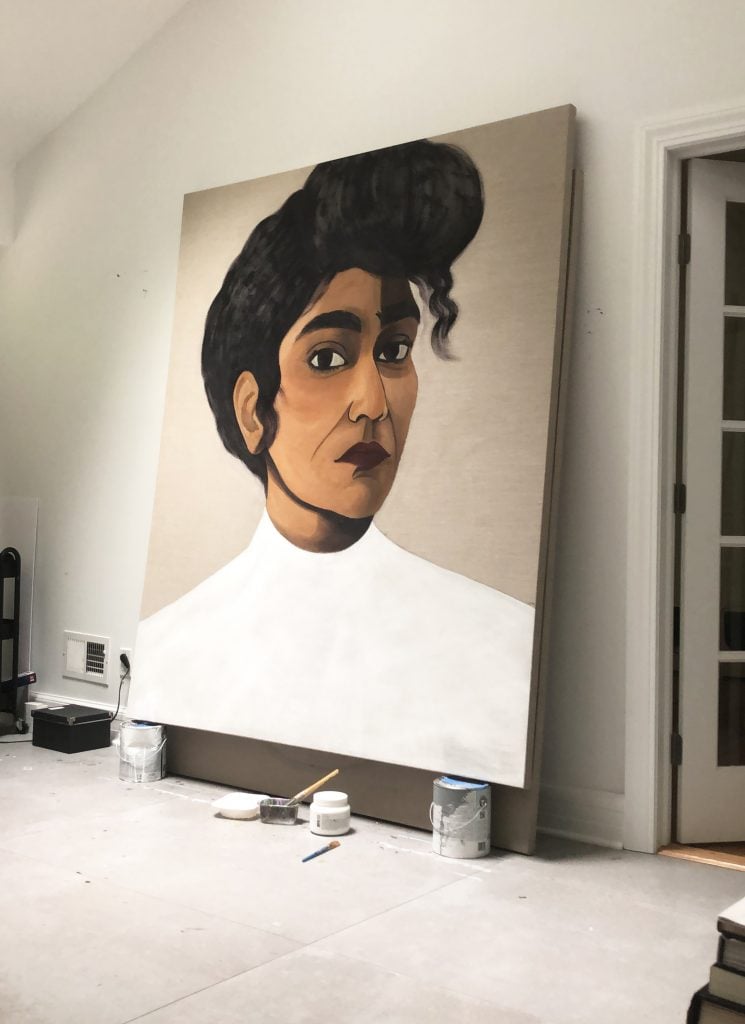
Maya Varadaraj’s New Rochelle studio. Courtesy of the artist.
Having recently transformed a portion of the home she shares with her husband into a fully functioning studio, the artist has also taken her portraits to a monumental scale, a process Varadaraj said inspires a sense of respect and reverence for these people in her life.
Recently, we spoke with Varadaraj, who told us about her favorite studio visitor (hint: it’s her cat!), the activity that jumpstarts her creative process, and the unlikely studio object that means the world to her.
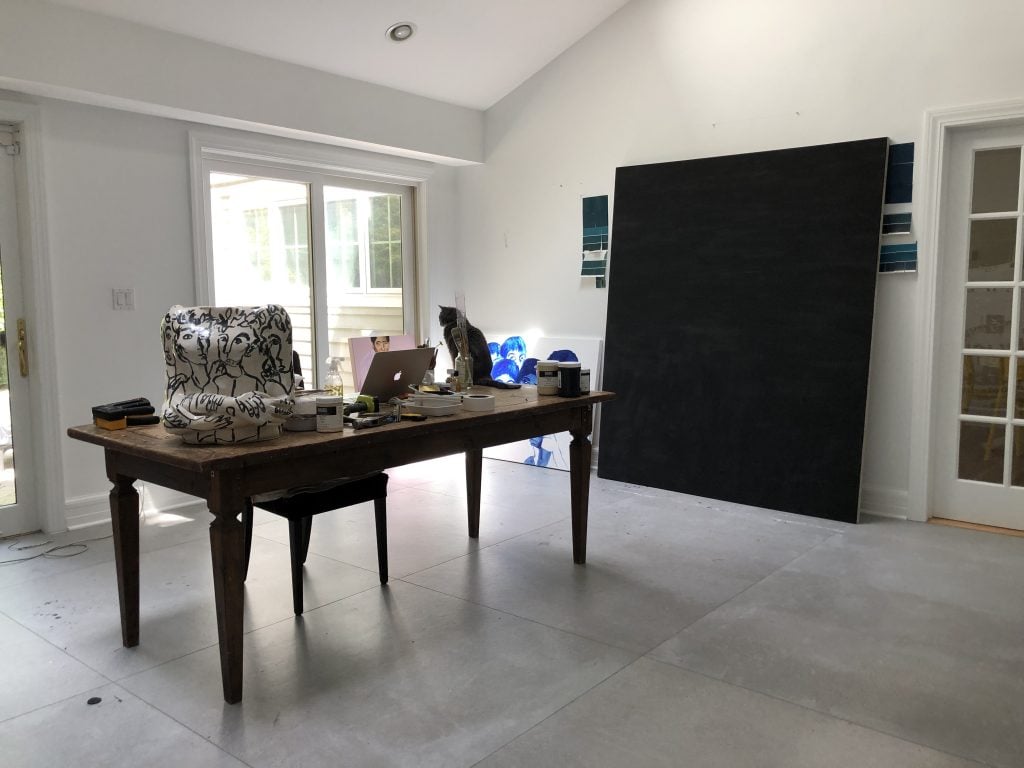
Maya Varadaraj’s New Rochelle studio. Courtesy of the artist.
Why do you like having your studio in your home?
Because the work never stops! I’m always thinking about it so if I want to just hop in there and do something it needs to be accessible, so having a studio at home has been such a big blessing. And I have a pretty big space, too. Before I was literally working on my coffee table and had one wall space where I could make work. The largest scale I could work at was 60 by 48 inches, but now I’m making much bigger work, which feels incredible.
What do you like to listen to or play when you’re in the studio?
I need to have something that I’m very familiar with playing in the background. Honestly, I love to have Harry Potter movies in the background. I can follow those conversations and even time my painting to them now. I’ll put on the first movie to do most of the underpainting and once that’s done, I’ll start the skin tone coloring to the second movie, and by the third movie, I’m moving on to the background. It keeps me focused. I can time myself without looking at my phone.
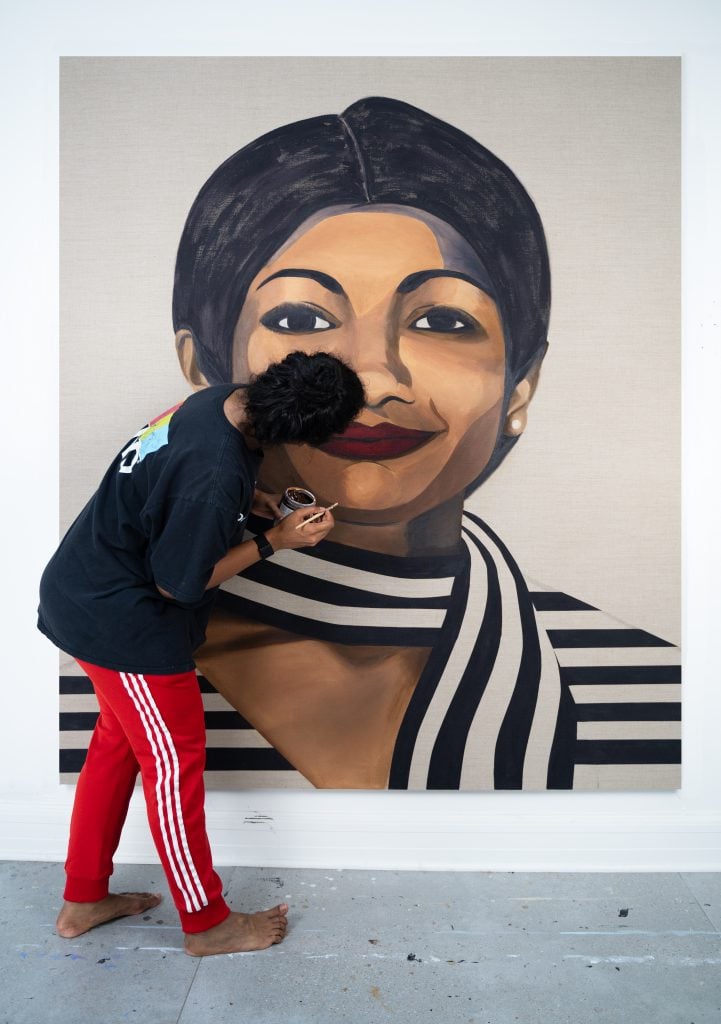
Maya in the studio. Courtesy of Aicon Contemporary.
Do you have a routine for your days in the studio?
I wake up in the morning and I do my Wordle. Then I start painting or drawing or wherever I am in the process. A lot of my work prior to painting is done digitally. I do a lot of digital research or digital sketching and since I work primarily with painted photographs, I have an archive of photographs that I continue to collect. I spend time organizing those, pulling them into Photoshop, picking colors, and trying different compositions with them. For a lot of the portraits, I wasn’t just drawing from one photograph but making a composite sketch from a couple of different photographs. Drawing digitally, I want to see if there is any patterning that I can do, playing with different color schemes. Once that’s all done, I can understand how big or how small I want to work.
You used to work on a very small scale, right? How has going to a bigger scale changed your work, if at all?
I went from working in miniature, 10 by eight inches to 80 by 66 inches. It’s been so interesting; the work feels completely different. When I’m working on a small scale, it feels like I’m getting very intimate with the image, and I have a lot of control over the image. It feels similar to a parent-child relationship. When I go to the larger scales, it doesn’t feel that way anymore. I feel as thought I’m conversing with an adult and there’s a little bit more respect. All of these emotions and memories are held in the faces, and it takes more confidence to go bigger. Working with photographs at that scale, you never know how it’s going to turn out. There’s something nice about that because part of the process is so controlled, and then the rest of it feels surprising, and it gives you space to sort of explore and be more experimental with it.
For the works in your current solo show, you mentioned to me that you think a lot about fabrics in your portraits and that it reflects your family’s history with the textile industry. How so?
After the Civil War in the United States, India became one of the major targets to push cotton farming under the British Empire. My great-grandfather became a grower in cotton farming, ultimately leading him into the transportation business. Meanwhile, my mother’s family owns textile mills, which were also a part of the cotton industry, especially in the city where I grew up, Coimbatore. That city and the surrounding cities are a big hub of producing garments for a lot of the big retailers in the West even today. But it wasn’t until this year that I learned all about the Civil War. I came to the States as a teenager and I’m a citizen here, but I’ve always wondered what brought me here. Learning about the Civil War and how that affected my family feels very circular and entwines the two together.
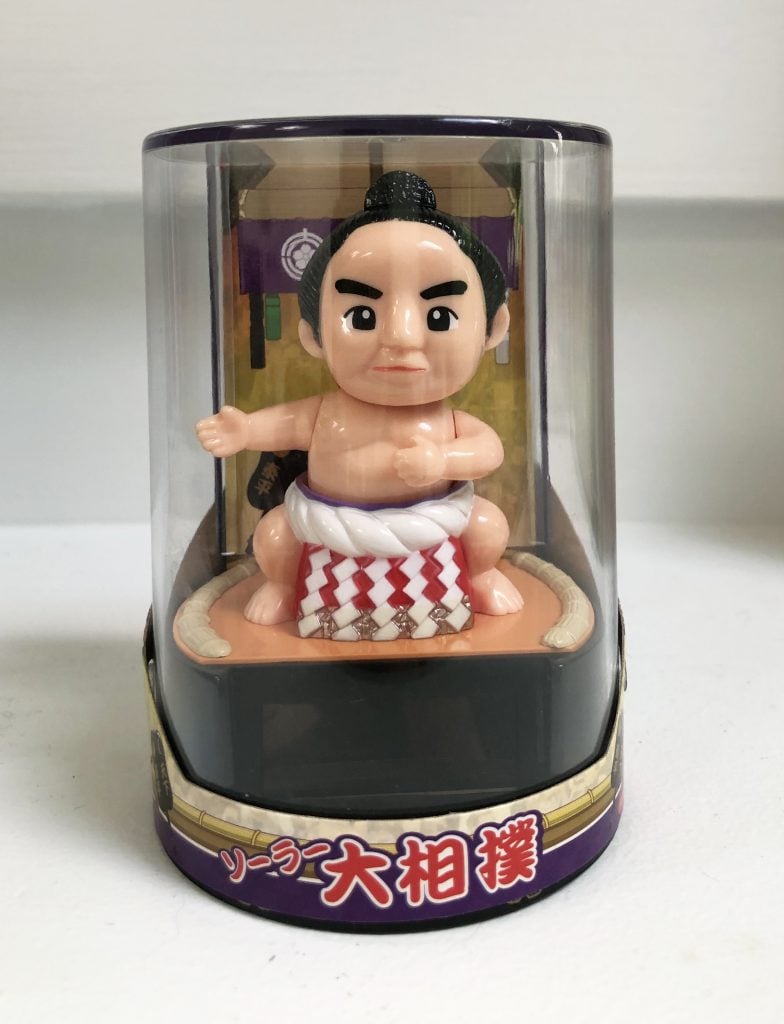
A toy Sumo wrestler that the artist’s brother gave her. Courtesy of the artist.
Do you have a favorite tool or object in your studio?
My brother bought me a Sumo wrestler bobblehead when he was in Japan. It moves in place and calms me down. It reminds me of my family and that I have their support, even though sometimes I’m working alone in my studio. I think of it as a cute little reminder that there’s nothing so serious in life. Things can be very simple if we want them to be.
When you feel stuck in the studio, what do you do?
I might just give myself a complete break and watch TV or read. When I was prepping for this show, I had a lot of those days because a lot of the stuff I’m painting felt heavy. Even though it’s therapeutic, I also need a break from thinking about it. Reading Rilke’s poems was a really nice reset. Instead of having to soothe myself, I was reading about someone else who was soothing themselves. When you read the book, it feels like two artists just giving each other advice. It felt as though I was talking to a friend and they were telling me to take it easy and that it’s okay. It was very centering for me. And it didn’t feel as though I was procrastinating but progressing somehow.
You’re also very into exercising, as well, right?
Yeah, I love weightlifting. It challenges me and makes me incredibly strong. When I had my first miscarriage, the first thing I did was go and weight lift, because it pulls you out of that feeling of feeling vulnerable. It puts you directly into a position where you have to feel confident. It shows you what your body is capable of and it really grounds you because you’re working in relationship to gravity.
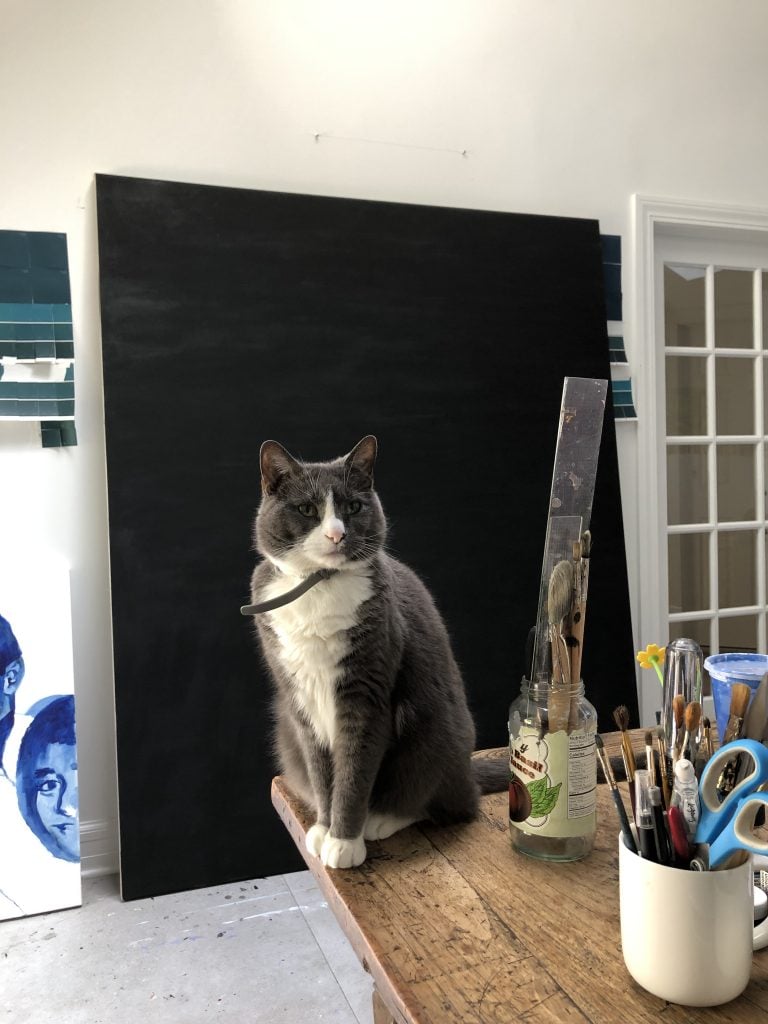
Benedict Arnold Paddington, the Third, the artist’s studio companion. Courtesy of the artist.
Your cat comes into your studio a lot. What’s his name?
Benedict Arnold Paddington the Third, but we call him Paddington. He’s my dire wolf, and then my husband has Francis Appleton Napoleon the First, and we call him Poe, but Poe doesn’t really hang out with me in my studio.
What are you working on now that you have the solo show up?
I have nothing on the horizon after back-to-back solo shows, one last year and one this year. When you have solo shows, there’s just nothing else that you can think about because you’re thinking about the concept and how the show’s going to come together. I’m really excited to just keep the momentum that I have. I’m working in a ceramic studio all the time. I feel much freer since I don’t necessarily need to fit this work into the narrative of a show. So I’m not putting too much pressure on myself! I do have little print edition with the Wassaic Project scheduled. I’m really excited about that. I had a residency with Wassaic Project last year, which was life-changing and I met some of my best friends there.